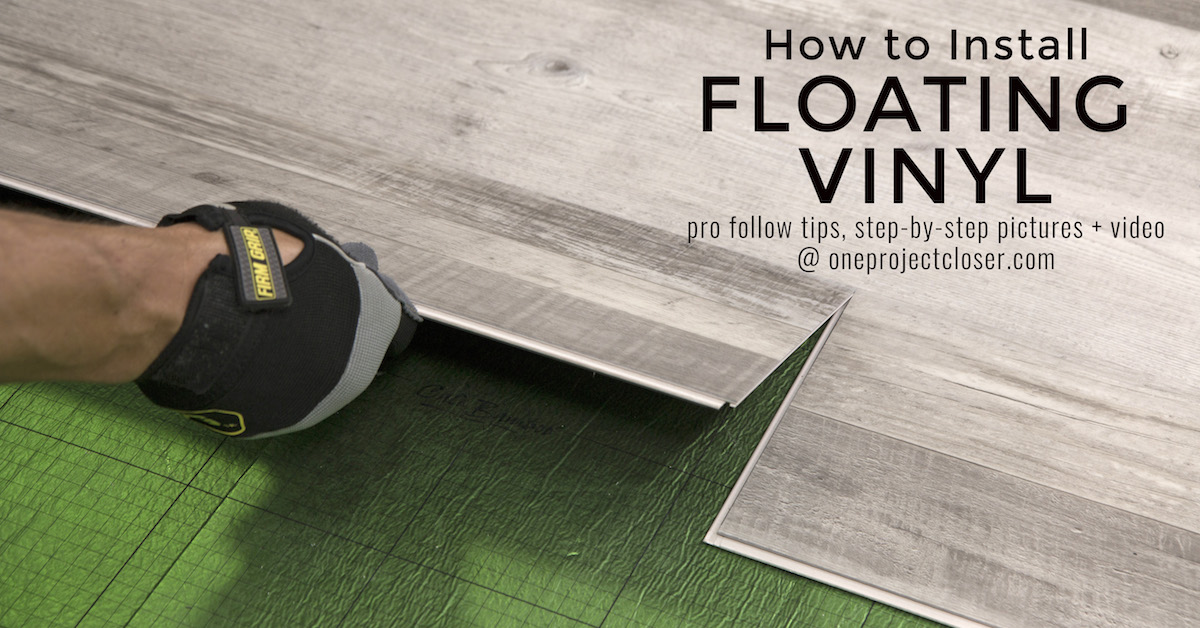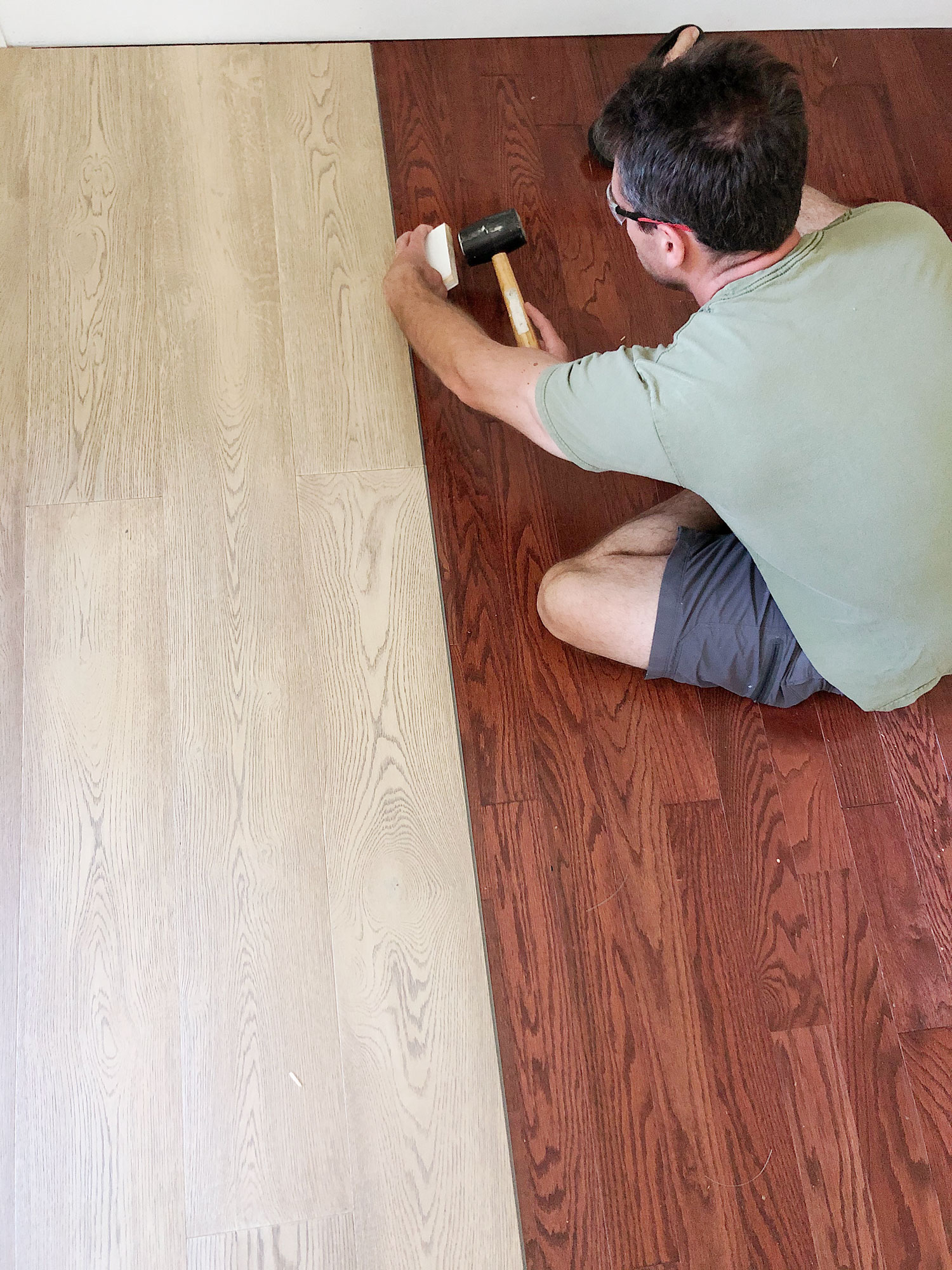Imagine stepping into your living room, greeted by the cool, smooth surface of tile. But something feels amiss. Perhaps you’re craving warmth underfoot, or the tiles are showing wear and tear after years of use. A floating floor promises a fresh start – but can it be laid directly over your existing tile? The answer, as with many home improvement questions, is not a simple “yes” or “no.” Your project’s success hinges on a few crucial factors, and this guide will help you navigate those complexities with confidence.

Image: www.oneprojectcloser.com
Laying a floating floor over tile presents a unique challenge. While it sounds appealing to avoid the hassle of removing the existing tile, it’s essential to understand the potential pitfalls and ensure your chosen approach is safe and long-lasting. This article will explore the pros and cons of this project, outline the steps for success, and offer practical advice from experienced flooring experts.
Why Consider Floating Floors?
Floating floors, also known as locking floor systems, have gained immense popularity in recent years, offering a range of benefits that make them appealing for homeowners:
- Ease of Installation: Compared to traditional glued-down floors, floating floors are often easier to install, making them a DIY-friendly choice.
- Cost-Effectiveness: Floating floors can often be budget-friendly, particularly when compared to other flooring options, including hardwood or ceramic tile.
- Versatility: Floating floors come in a wide range of materials, including laminate, engineered wood, vinyl, and cork, creating diverse design possibilities to suit any style.
- Comfort: Floating floors offer superior insulation, making your home feel warmer and more comfortable, especially in colder climates.
- Sound Attenuation: Floating floors contribute to noise reduction, making them a good choice for apartments or homes where noise can be a concern.
The Pros and Cons of Installing Floating Floors Over Tile
The decision to install a floating floor over tile comes with both advantages and disadvantages, and it’s crucial to weigh these carefully before making a final call:
**Pros:**
- Time and Cost Savings: Avoiding the arduous task of removing existing tile can save both time and money. This is especially appealing when faced with a large or complex project.
- Hidden Problems: If your tiles are well-adhered and structurally sound, they can provide a stable base for your new floor, effectively hiding any underlying imperfections.
- Increased Insulation: Having an extra layer of insulation between your floating floor and the tile can improve your home’s energy efficiency and comfort.
- Versatility: The wide array of floating floor materials allows you to easily change the look and feel of your space, without needing to rip up the entire floor.

Image: viewfloor.co
**Cons:**
- Uneven Surfaces: Minor variations in the tile’s surface, like cracks or gaps, can become amplified by the added layer of floating floor, resulting in a visible unevenness.
- Sound Transmission: While floating floors generally offer good sound insulation, installing them over existing tile can result in more noise transmission when walking.
- Moisture Issues: Tile is typically impervious to moisture. However, moisture trapped between the tile and your floating floor could lead to warping, buckling, and other structural issues.
- Limited Warranty: Some manufacturers might void their warranties if you install floating floors over tile. It’s essential to consult the manufacturer’s guidelines and speak to your flooring retailer.
A Comprehensive Checklist: Can Your Project Succeed?
Before taking the plunge, thoroughly assess whether your existing tile is suitable for a floating floor installation:
- Adhesion: Ensure the existing tiles are firmly bonded to the subfloor. Loose or cracked tiles pose a significant risk and must be addressed before proceeding.
- Surface Flatness: While some minor irregularities are acceptable, significant variations need to be addressed for a successful installation. A maximum levelness deviation of 1/8 inch is generally recommended.
- Moisture Issues: Ensure the subfloor under the tiles is dry and free of moisture. Any signs of moisture or previous water damage must be rectified before installing a new floor.
- Material Compatibility: Certain floating floor types are better suited for installation over existing tile. Consult with flooring experts to determine the best material for your situation.
- Structural Integrity: Assess the condition of the subfloor underlying the tile. If it’s damaged or weakened, it must be repaired before installing a floating floor.
Steps to Install a Floating Floor Over Tile
If the above checklist reveals your tile floor is suitable, you can proceed with the installation:
- Clean the Tile: Thoroughly clean the tile surface using a suitable degreaser to remove any dirt, grime, or residue.
- Prepare the Surface: Evaluate the tile’s surface for any imperfections. Fill in grout lines and smooth out any rough edges to create a level, smooth base.
- Install a Moisture Barrier: Regardless of your installation type, it’s crucial to install a moisture barrier under your floating floor to safeguard against potential moisture issues.
- Select the Right Underlayment: Choosing the right underlayment is crucial for maximizing comfort, sound insulation, and stability. Consult with flooring experts for recommendations based on your chosen flooring material.
- Start the Installation: Follow the manufacturer’s instructions for laying your chosen floating floor, aligning the first row carefully against a straight wall.
- Secure the Floor: Use a tapping block and mallet to gently tap the locking mechanism of each plank, ensuring a secure and even fit.
- Finishing Touches: Cut and install the last rows, ensuring a clean, flush finish against walls.
- Edge Trims: Use matching wall base or molding to hide gaps between the floating floor and the wall, creating a refined and professional look.
Expert Tips for Success
- Don’t Cut Corners: While a floating floor installation can be DIY-friendly, it’s vital to follow the manufacturer’s instructions precisely and avoid shortcuts.
- Leave Expansion Gaps: Always leave expansion gaps along walls and other fixed areas to allow for natural expansion and contraction of the flooring material due to temperature changes.
- Consult Professionals: If you have doubts or the project seems complex, don’t hesitate to seek advice and assistance from flooring professionals. They can offer expert guidance, assess feasibility, and ensure a successful long-lasting outcome.
Can I Put A Floating Floor Over Tile
https://youtube.com/watch?v=hNha9JSt2JE
Conclusion
Installing a floating floor over existing tile can be a smart and cost-effective way to upgrade your home’s aesthetic and comfort. But remember that this project requires careful consideration and thorough planning. By carefully evaluating your tile floor’s condition, understanding the pros and cons, and following expert advice, you can achieve a successful and beautiful transformation. Remember to consult flooring professionals for personalized guidance and assistance, ensuring your new floating floor brings years of enjoyment to your home.






